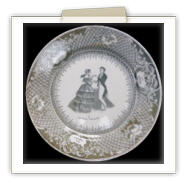(1835 - 1866) Earthenware and its industrial revolution in Longwy with d'Huart de Nothomb
In 1835, Henri-Joseph d'Huart, who married Fanny de Nothomb, took over the management of Longwy and Audun-le-Tiche. It modernizes the company and makes it enter the industrial era. In 1836, the development of a new glaze made it possible to compete with the fine, hard English-style faience made by competing companies. From 1838, the use of coke is generalized as a combustible for cooking parts, which makes it possible to compensate for the difficulty of supplying wood. The rendering of the biscuits seems to benefit from the combustible change, since they become whiter.
In 1839, Henri-Joseph d'Huart filed a patent for a tiled oven of improved design. A sales tariff of this time (1840) allows us to know the range of products offered for sale:
- Fine earthenware category with 4 models of dishes, 12 models of plates and 21 pieces of form
- "blanc-fin" category with 1 dish model, 4 plate models and 8 shaped pieces. In 1842 he bought the mill Senelle (location of large offices today) to grind clay.
In 1847, he built a blast furnace next to it and developed a process for recovering the so-called lost gases collected at the top to be used as combustible booster, which presupposes the existence of a furnace. faience nearby. In terms of decoration, around 1840 the company adopts the technique of printing. This period sees the decorations common to several factories, because at the beginning the plates were probably bought from specialized manufacturers.
A little later, between 1850 and 1852, the short passage of British decorator G. Vernon marked the development of English-inspired sets. The size of the factory workforce fluctuates according to the circumstances, with about 50 workers in 1835 and 150 workers in 1856.
This period will be plentiful in awards and honorary awards at numerous exhibitions in Paris and the provinces. In 1866 he transferred the company to his two sons Fernand and Hippolyte.









